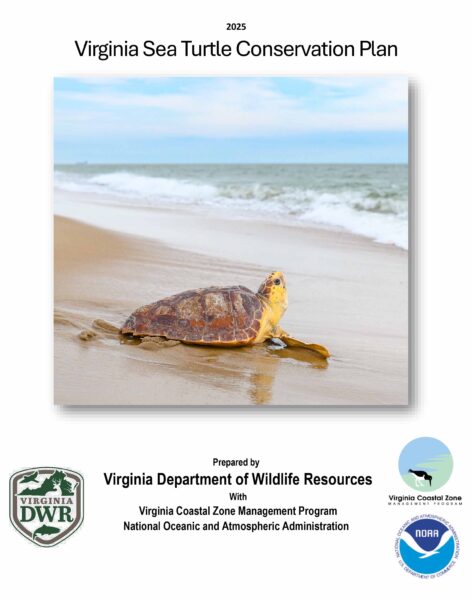 Loggerhead, Kemp’s ridley, green and leatherback sea turtles regularly occur in Virginia waters and all four species are protected under the Virginia and U.S. Endangered Species Acts. Loggerhead and green turtle populations that occur in Virginia are state and federally listed as threatened whereas leatherbacks and Kemp’s ridleys are state and federally listed as endangered.
Loggerhead, Kemp’s ridley, green and leatherback sea turtles regularly occur in Virginia waters and all four species are protected under the Virginia and U.S. Endangered Species Acts. Loggerhead and green turtle populations that occur in Virginia are state and federally listed as threatened whereas leatherbacks and Kemp’s ridleys are state and federally listed as endangered.
As highly mobile marine mega-vertebrates, none of these species spend their lives exclusively in Virginia. Juvenile loggerhead, Kemp’s ridley and green sea turtles migrate seasonally to Virginia to forage during their development into adulthood. Adult male and female loggerhead turtles have been tracked to Virginia from nesting beaches south of Virginia, presumably to forage after breeding activities. All three species nest in Virginia, but only loggerheads nest regularly in the state. Leatherbacks occur in Virginia at any time of year but are most often present in the spring. To date, no leatherback nesting activity has been documented in Virginia despite the fact that nests have been reported in states to the north and south of the Commonwealth.
Because sea turtles that occur in temperate habitats are migratory animals with wide ranges, it is necessary to coordinate conservation efforts with those of other state, federal and international entities. Although threats to sea turtles in Virginia are consistent with those reported throughout the mid-Atlantic region, the density of turtles compared to areas north of Virginia appears to be relatively high in Virginia; thus, making the conservation and management of sea turtles and their habitats especially important in the Commonwealth. Sea turtle injuries and mortality are primarily attributed to anthropogenic activities including commercial and recreational fishing gear, hopper dredges, and vessel strikes. Although cold-stunning is a natural phenomenon, global climate change has contributed to an increase in the variability of fall and early winter coastal water temperatures, which has led to a rise in the numbers of turtles affected. Non-lethal, compounding stressors may also be compromising animals, making them more susceptible to disease, parasites, and cold stunning. These stressors include low levels of contaminants and poor prey and water quality (resulting from various types of pollution), shifting prey bases, invasive species, harmful algal blooms, marine construction, and military activities.
The overarching goal of this Plan is to enhance the survival and conserve the habitats of sea turtles in Virginia in a manner that is consistent with regional and federal research, management, and conservation efforts. There are three conservation goals under which strategies and actions with lead agencies and timelines are described. The three goals discussed below are:
- Conservation Goal 1: Maintain a permanent and effective Sea Turtle Stranding and Salvage Network in Virginia
- Conservation Goal 2: Identify and mitigate risks to sea turtle populations and habitats in Virginia through cost-effective monitoring, research, and best practices.
- Conservation Goal 3: Promote sea turtle conservation in Virginia through social marketing and information dissemination.
As the agency responsible for conservation and management of protected species, the Virginia Department of Wildlife Resources (DWR) is responsible for developing state conservation plans.
Coordination and communication between the DWR and the Virginia Marine Resources Commission, the two state agencies responsible for managing protected marine species in the Commonwealth along with NOAA Fisheries and the U.S. Fish and Wildlife Service, which provide national oversight, is a key aspect of sea turtle conservation in Virginia. This plan aligns with and builds on federal recovery efforts described in species recovery plans and status reviews. Moreover, the successful implementation of most of the conservation strategies and actions identified in this Plan rely heavily on the cooperation of many other collaborating agencies, organizations, and partners who will also be key to communicating with the general public. Since sea turtle conservation fundamentally includes human beings, the most successful conservation actions will be those aligned with the values, wellbeing, and perspectives of people who are expected to support lasting change. Finally, this Plan was developed in concert with the 2024 Marine Mammal Conservation Plan (MMCP) and many of its strategies and actions are similar to those identified for sea turtles. The coordination and implementation of related efforts outlined in both plans should be executed in a way that maximizes limited state resources and provides the greatest conservation benefits for both species groups.

